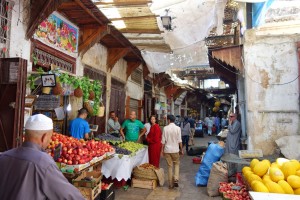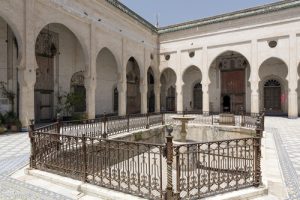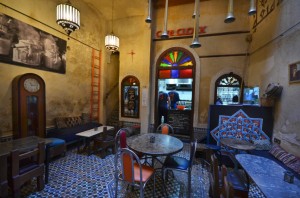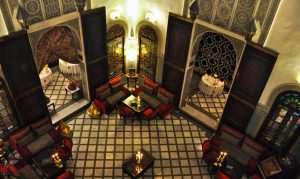Fez has been called the “Mecca of the West” and the “Athens of Africa.” Once you go there, you’ll see why. Known as the cultural capital of Morocco, Fez is an incredibly popular tourist destination, mostly on account of its thriving medina, artistic flair and stunning architecture. There are not only a boatload of museums here, but also tanneries, artisanal craftsmen, art galleries galore, and creative cuisine in the many chic restaurants. Life today still goes on in Fez much the way it did 1,300 years ago; the city is one of the largest car-free urban areas in the world.
Orientation and attractions
Fez is located in the northeast part of the country between the Riff and Middle Atlas mountains. Gates (babs) are located around the city which are helpful for finding your way around. There is also a path network around the city that is marked by signs on the walls by an 8-point star shape. The main street is the Talaa Kbira and it runs between Bab Boujloud to the heart of the medina. If you find yourself getting lost, the best best is to walk downhill which will take you to the edges of the city and out of the medina.
With 9,000 proper streets and 40,000 dead ends, the fact that you will lose your way in Fez’s medina is a foregone conclusion. But it’s also half the fun: there’s no better way to immerse yourself in the fabric of the city’s daily life than to meander through its neighborhoods as residents cart home bread and groceries for breakfast, cycle to work, stroll to the mosques for prayers, transport furniture via donkey, tote their soap and towels to the neighborhood hammam, sip tea on their stoops, and gossip in the alleys.
It’s best to start off in the Andalusian Quarter by the Bab Jdid, a relatively quiet, residential part of the medina that has a tranquil feeling. This will give you a dose of the daily routines of the area. After immersing yourself, head over to the R’Cif market, the biggest in the city, full of vendors selling vegetables, spices, eggs, and glistening baskets of olives. Beyond the market, there are many buzzing neighborhoods. There is the the dyers’ street, where men daub strands of aloe vera silk in myriad vibrant colors; Nejjarine Square, where the carpenters work; Attarine Street, where perfumers ply their fragrant wares; and the tree-shaded Seffarine Square, where coppersmiths mould pots and urns with their mallets.
From Seffarine Square, follow a wood-paneled artery that plunges you into the heart of the medina. Nearby is a university that was founded by a woman in the year 889, making the institution presiding over 5.7 acres of medina real estate the oldest in the world — Pope Sylvester II, who studied there in the 11th century, is an alumnus. The mosque, built to accommodate 14,000 worshipers, was once the biggest in the world.
Another great attraction is the 18th-century mosque of Sidi Ahmed Tijani and the gilded tomb of Moulay Idriss. Take some time to observe the architecture there and people milling around before heading over to Fez’s famed tanneries. Here, people have been fashioning leather out of animal skins using the same stinky method (pigeon poop is a major ingredient) for seven centuries. While the chic leather jackets and stylish clutches seen in the boutiques lining the terrace overlooking the tanneries are decidedly modern, the methods use to create them are quintessential Fez, as ancient as the city itself.
For some more architectural wonders, head to the Palais El Mokri, which is located in the southern part of the Fez medina near the Bab Jdid Gate, was built by Si Tayeb El Mokri, who served as Minister of Finance to Sultan Moulay El Hafid until 1912. He then served Sultan Mohammed V (who later became King of Morocco) as Pacha of Casablanca from 1927 until his death in 1949.
Dining
Once you’ve finished your adventure and are ready for a break, make a detour to the trendy Fez Lounge, a tiny joint set on a quiet side nook just off one of the medina’s main drags. The stylish café could be in Madrid or New York, with plush couches, muted decor in shades of taupe and plum, and a smooth, jazzy sound track. It’s a great place to unwind with Moroccan-style tapas, mint tea, and a sheesha pipe and ease your way back into the 21st century.
If you want to eat well and also learn to cook, head to Café Clock. Built in a restored 250-year-old house, this is a haven for locals and foreigners – a café and a center for cultural exchange. From the menu options you can eat and make zalouk – the smoky spiced roasted aubergine dip, or a delicious harira soup – a hearty soup popularly found all over Morocco, or the delicate pastilla or b’stilla.
For some of the best vegetarian cuisine (with tagine of course) and best views of the city, try Le Kasbah Restaurant. This budget friendly option features a view overlooking the Bab Jdid Gate and medina as you sit comfortably on an open-air terrace. It also tends to be a place where a good amount of travelers meet up to chat, if you are looking for a break from the bustling streets below. If you’re not looking for a veggie meal, definitely go with the lamb chops.
Where To Stay
A day walking around Fez can easily wear out even the most experienced traveler, so it’s important to get a good night’s rest in order to keep up with the pace of the city. Though there are numerous modern hotels, the quintessential way to experience Fez is to stay in a traditional riad.
Riad Maison Bleue is the grande dame of the Fes riad circuit. The 18 suites are each unique, ranging from thoroughly authentic to über-modern with some local details added for good measure. the interiors are a maze of terraces, stylishly appointed courtyards, and assorted nooks, all adorned with antique clocks, statues, and framed yellowing Arabic newspaper clippings lining the hallways. It’s also got a Maison Cordon Bleue cooking school, a lovely rooftop spa and a hammam.
Palais Amani, in the Fes medina, marries traditional Moroccan architecture and style with a 1930s Art Deco design scheme. The rooms are modern, with sleek purple couches, large color photographs of daily medina life, and tile and granite bathrooms with mini tagines bearing potpourri next to the toilets. The mosaic-tiled outdoor showers on the roof deck are perfect for cooling down after a day of sunbathing. The hotel also offers a beautiful French-Moroccan restaurant and a spa with a hammam.
Riad Le Calife is a fabulous location and offers five-star service to help you relax after a day in the Medina. The cozy dining room plays jazz music and you will feel like you’ve been transported away to an earlier time in Morocco. Head up to the rooftop terrace to enjoy an amazing view of the Medina along with a panoramic view of the nearby Atlas mountains. The courtyard is also beautifully decorated and features relaxing fountains to compliment the rest of the surroundings.
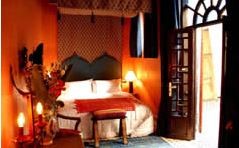
Algila Fes Hotel (Courtesy of Algila Fes)
Another spot that will take you away to another world is the Algila Fes Hotel. The location features 12 guest rooms and suites that offer a stylish yet contemporary take on traditional Moroccan decor. Beautiful tile work is found throughout and the walls are adorned with hand woven fabrics. Food here is great and the staff is known to be super friendly and knowledgeable.
For those looking for a luxury getaway, the Palais Faraj Suites and Spa offers a top-tier experience in the Ziat district. Built in a former Arab-Moorish palace, the hotel features a swanky bar surrounded by glass windows with a 360-degree view around the city. The outdoor pool is amazing and makes a perfect place to cool off after a hot day in the city. A hammam is available onsite, offering some of the best massage treatments you’ll ever find.
Excursions
The Roman ruins at Volubilis are one of the most popular places to go on a day trip from Fez. While parts of it are crumbling, it still offers spectacular mosaics and numerous photo opportunities. The city was developed in the 3rd Century BC as a Phoenician, Carthaginian and later a Roman settlement. After an earthquake in the 18th century, much of the city was looted by Moroccan rulers looking for stone to build Meknes. It’s now a UNESCO World Heritage Site and one of the best examples of a large Roman colonial town on the outside of the empire. Coach tours are available from Fez and run daily, but you can also go by yourself with some careful planning.
If you’re looking for history and a bit of nature, Azrou also makes a great day trip. The city is known for having the first college of the Berber region and the city is surrounded by hillsides and mountains covered with cedar and oak forests that are worth exploring. The forest is home to Barbary macaques and the redheaded Moroccan woodpecker which you can often spot on a hike. There is also a market on the fringe of the city selling many traditional items, usually for much cheaper than you can get them for in the bigger Moroccan cities.
Ouzoud Falls, located south of Fez in the Grand Atlas mountains, is worth the trip if you’re a nature lover. It’s a bit further than the other excursions — it’s almost halfway between Marrakech and Fez, so you may want to visit it on the way to or from either place. You can get there by bus, but a taxi is more fun (don’t pay more than US$30/MAD290 per person!), and the local driver may blast some thumping Berber music as you wind your way up into the rugged mountain terrain. There are few hotels, so book ahead if you plan to stay overnight. The entire village hugs the falls from above. When you hike down to the base, take a dip in the crystal pools with village women and children.
Getting there and around
The Fes-Saiss Airport (FEZ) is located about 15km (9.3 miles) outside the city and is served by several European and African airlines, including budget carriers such as Ryanair. If you are flying in from abroad, you may however need to connect in Casablanca.
From the airport, you can either choose to take one of the blue buses into the city, an airport shuttle, or a taxi. The bus and airport shuttle make the cheapest option and will help to ensure you aren’t scammed by one of the taxi drivers.
Most travelers already in Morocco take the train. Trains to Fez regularly depart from Casablanca, Tangier, Rabat and Marrakech. You can also take a “grand taxi” from Casablanca, worth is considering if you are traveling with a group.
Once in Fez, it’s pretty easy to just stroll around the medina and use the red taxis to maneuver you around the edges of the city. You can pick them up from any of the gates. If you don’t feel comfortable exploring on your own, there are plenty of licensed guides who can show you around. Ask your hotel for a recommendation. The streets can be a bit disorienting at times, so using a compass to get a sense of direction can actually come in handy.
Practical Considerations
Languages: Most people in Fez speak the Moroccan dialect of Arabic (Darija), but many people also speak French fluently. Few people speak English outside of the younger generation.
Location: Fez is the third-largest city in Morocco, and is located in the northeast part of the country between the Riff and Middle Atlas mountains. The city is at the crossroads of old caravan routes that connected the Saharan empires with the rest of the Mediterranean.
Weather: Fez enjoys a comfortable Mediterranean climate, with cool, wet winters and warm dry summers. Temperatures range from highs around 58F (15C) in January to 96F (36C) in July.
Safety: Many people will approach you in the street offering their services as a “tour guide” or even just to offer directions. This is an attempt to get money from you; they will ask for payment afterwards. If you’ve already agreed, then pay up, but if you want to avoid future assaults on your wallet, simply say no before agreeing to anything. You’ll also need to practice your bartering skills in Fez, which has one of the largest and oldest medieval souks in all of Africa. Vendors can be overly pushy, so be sure to stand your ground.
Hospitals: The local hospital is Hôpital Ghassani (055 622777), located east of the Ville Nouvelle in Dhar Mehraz.
Emergency Numbers:
- Fire Department & Ambulance: 15
- Police: 19 (City), 177 (countryside)
Money and banking: The Dirham (MAD) is the currency in Morocco and you can get it at before entering the country, or once you enter. There is a Bureau de Change on the left as you leave the customs hall at the Fez Airport. An ATM can be found at the airport as well, though it’s not always working. Inside the medina, you’ll find a branch of the SGMB bank at Bab Bou Jeloud. It’s open Monday to Thursday 8:15 a.m. to 4:00 p.m. and Friday and Saturday 8:30 a.m. to noon. The ATM is 24 hours, accepts all cards, and changes foreign currency.
Local customs: Morocco is primarily a Muslim country, therefore women are advised to cover their shoulders and legs in public areas.
More Information: Moroccan National Office of Tourism
